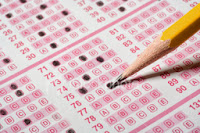(A) armature resistance only
(B) armature resistance and leakage reactance
(C) armature resistance, leakage reactance and armature reaction
(D) armature resistance, leakage reactance, armature reaction and earth connections.
2. The magnitude of various voltage drops that occur in an alternator, depends on
(A) power factor of the load
(B) load current
(C) power factor x load current
(D) power factor x (load current)2.
3. In an alternator, at lagging power factor, the generated voltage per phase, as compared to that at unity power factor
(A) must be same as terminal voltage
(B) must be less than the terminal voltage
(C) must be more than the terminal voltage
(D) must be 1.41 time the terminal voltage.
4. The power factor of an alternator depends on
(A) Load
(B) Speed of rotor
(C) Core losses
(D) Armature losses.
5. Which kind of rotor is most suitable for turbo alternators which arc designed to run at high speed ?
(A) Salient pole type
(B) Non-salient pole type
(C) Both (A) and (B) above
(D) None of the above.
6. Salient poles are generally used on
(A) high speed prime movers only
(B) medium speed prime movers only
(C) low speed prime movers only
( D) low and medium speed prime movers.
7. The frequency of voltage generated in an alternator depends on
(A) number of poles
(B) rotative speed
(C) number of poles and rotative speed
(D) number of poles, rotative speed and type of winding.
8. The frequency of voltage generated by an alternator having 8 poles and rotating at 250 rpm is
(A) 60 Hz
(B) 50 Hz
(C) 25 Hz
(D) 16 2/3 Hz.
9. An alternator is generating power at 210 V per phase while running at 1500 rpm. If the need of the alternator drops to 1000 rpm, the generated voltage per phase will be
(A) 180 V
(B) 150 V
(C) 140 V
(D) 105 V.
10. A 10 pole AC generator rotates at 1200 rpm. The frequency of AC voltage in cycles per second will be
(A)120
(B) 110
(C) 100
(D) 50.
11. The number of electrical degrees passed through in one revolution of a six pole synchronous alternator is
(A)360:
(B)720
(C) 1080
(D)2160 .
12. Fleming’s left hand rule may be applied to an electric generator to find out
(A) direction of rotor rotation
(B) polarity of induced emf
(C) direction of induced emf
(D) direction of magnetic field.
13. If the input to the prime mover of an alternator is kept constant but the excitation is changed, then the
(A) reactive component of the output is changed
(B) active component of the output is changed
(C) power factor of the load remains constant
(D) power factor of the load reduces.
14. An alternator is said to be over excited when it is operating at
(A) unity power factor
(B) leading power factor
(C) lagging power factor
(D) lagging to leading power factor.
15. When an alternator is running on no load the power supplied by the prime mover is mainly consumed
(A) to meet iron losses
(B) to meet copper losses
(C) to meet all no load losses
(D) to produce induced emf in armature winding.


